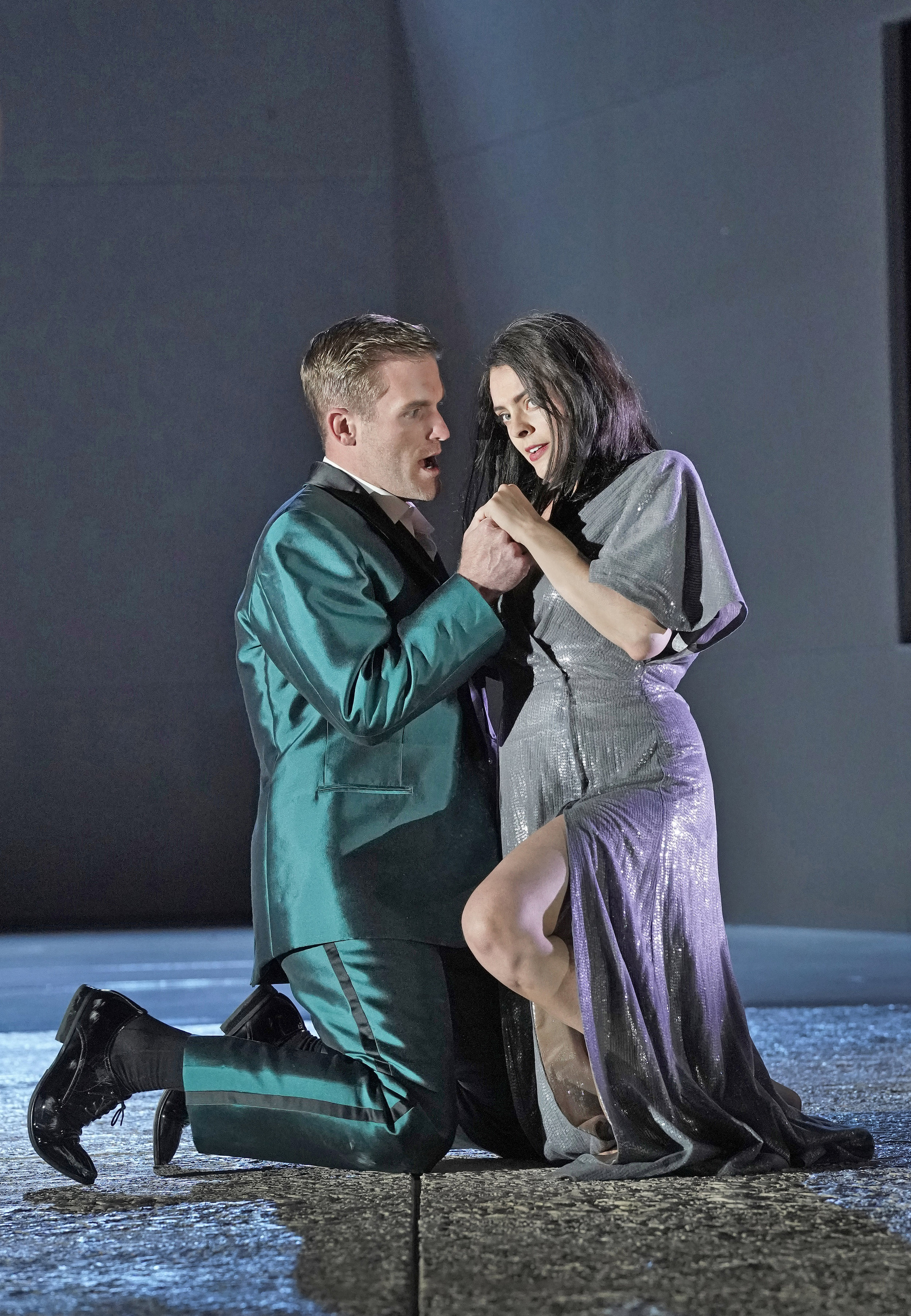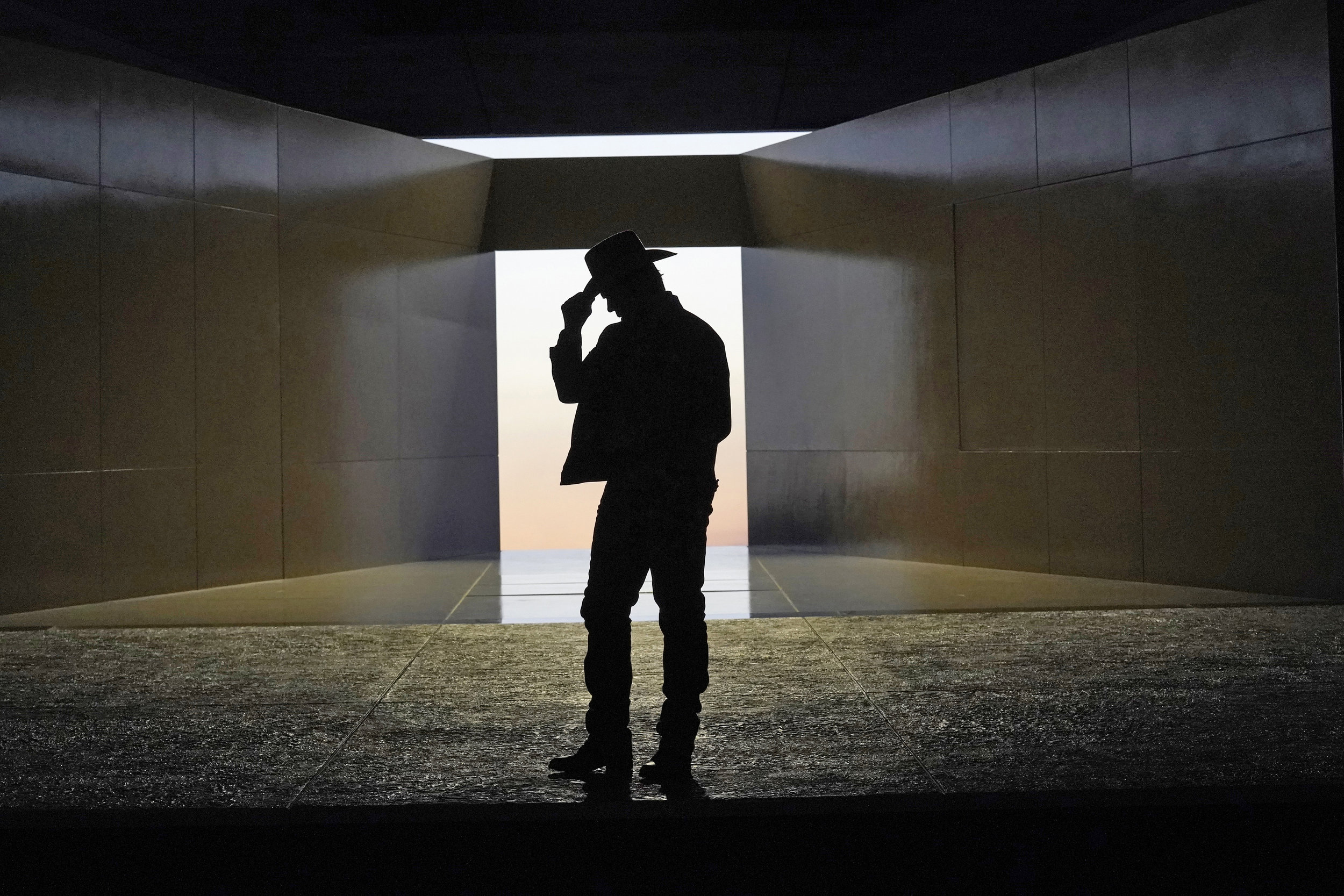(This is part III of a three-part series based on an August 2019 trip to attend two operas at the Santa Fe Opera. Part I on The Fan Experience was posted previously and followed by part II, reporting on the premiere of The Thirteenth Child.)
Cosi fan tutte illustration; image by Stuart McReath; courtesy of the Santa Fe Opera.
Sometimes you get surprised, and sometimes, it’s even a good surprise. The world premiere of The Thirteenth Child was the opera we went to Santa Fe to see. Cosi fan tutte was an add on because we were going to be there a few days and thought it would be fun to see two operas in our first trip to the Santa Fe Opera. Don’t get me wrong, Cosi is a great opera, and I anticipated that it would be enjoyable as always, for the music if nothing else. I knew it was going to be a “modernized” Cosi, which always makes me skeptical, but we were getting to see it at the Santa Fe Opera, a treat all by itself. In fact, SFO’s Cosi fan tutte turned out to be “the” opera to see, in my opinion, and my favorite Cosi so far.
This opera is one of the big three by composer Amadeus Wolfgang Mozart and librettist Lorenzo da Ponte (along with The Marriage of Figaro and Don Giovanni); this libretto, unlike the other two, is original with da Ponte, though the plot device of testing a mate’s fidelity was not. The story is simple but requires two leaps of faith, one that all this happens in a day, and two, that the boys’ and the maid’s disguises are adequate to deceive the girls. One also has to set aside moral judgement of the two young men; it’s a comedy, remember? Well okay, as listed by Mssrs. Mozart and da Ponte, a “drama giocoso” that has been described as a playful/serious duality. Regardless, your suspension of disbelief is well rewarded, until you realize even you have been duped, as your anticipation of laughs is replaced by anxiety. Two young men, Guglielmo and Ferrando, enter into a bet with a more mature and cynical acquaintance Don Alfonso that their girlfriends Fiordiligi and Dorabella will remain faithful to them when tempted. Alfonso enlists the young women’s maid, Despina, in his plan to make them believe that their young gentlemen have joined the army and have departed, then have the guys return disguised as two different suitors to test the girls’ faithfulness. Played as comical with a bit of slapstick thrown in, the disturbing undertones slowly rise to the surface and ends with everyone wiser, but no one happy. Cosi’s themes and messages ran against the zeitgeist of the 19th century, and the opera was disdained as lewd and immoral, unworthy of Mozart’s genius and its music co-opted for other productions. It was only until, roughly, the 1930’s that it became regularly produced and is now one of the more popular operas. It is remarkable how the estimation of a work’s greatness depends on the century from which it is viewed. Audiences and performance art are co-dependent; do you realize when you attend a performance you are a participant in the making of art? I digress.
l to r: Fiordiligi (Amanda Majeski), Guglielmo (Jarrett Ott), Don Alfonso (Rod Gilfry), Ferrando (Ben Bliss), and Dorabella (Emily D’Angelo). Photo by Ken Howard; courtesy of Santa Fe Opera.
During her pre-opera talk, Cori Ellison, SFO dramaturg extraordinaire, declared that the cast for this Cosi was a dream team. I assumed her assertion was to some degree company hype, but in fact, it was spot on. Each performer in a six-member cast deserved this superlative as part of their praise, a member of the Cosi dream team. Fiordiligi was brilliantly played by soprano Amanda Majeski, who I heard sing as Countess Almaviva in DC three years ago. She was good then; she is even better now! A commanding stage presence was united with her beautiful, expressive voice. Her lover Guglielmo played by baritone Jarrett Ott was well cast and matched his companions in quality of performance. A riveting portrayal of Dorabella was given by mezzo-soprano Emily D’Angelo, the winner of the 2018 Operalia competition; she demonstrates remarkable on-stage confidence. With a beautiful voice and singing, she made Dorabella’s transformation possibly the most poignant of the group. Tenor Ben Bliss played her lover Ferrando, completing a quartet of outstanding performances. Not to be outdone, baritone Rod Gilfry as Don Alfonso and veteran soprano Tracy Dahl as Despina carved their own niches in a powerhouse cast - Ms. Dahl was clearly an audience favorite. Each sang well and served effectively as cynical counterpoint to the naïve young lovers. Honestly, I can offer nothing but praise for all the arias and recitatives. Name your favorite Cosi aria; it was well done. Mozart was also the master of ensemble singing and Cosi is filled with duets, trios, quartets, quintets, and sextets. As good as all the voices were individually, they sounded as good or better when singing together. They were joined by a capable off-stage chorus (Chorus Master Susanne Sheston). Kudos to the cast and Mr. Mozart. Conductor Harry Bickett directed a lively orchestral performance that supported the vocals well but was worthy of listening to on its own. I am also going to make the case that SFO’s staging of this opera was outstanding, but clearly, singing of this caliber could override the deficiencies of just about any production, so bear that in mind.
l to r: Amanda Majeski as Fiordiligi and Jarrett Ott as Guglielmo embracing Emily D’Angelo as Dorabella. Photos by Ken Howard; courtesy of Santa Fe Opera.
Take away scenery; take away period costumes. Instead have grey walls and flooring, with a couple of escape hatches on the floor and a couple of access windows on the narrowing sides, simple costumes (e.g., tennis whites, suits, cowboy jeans and jackets) changed each scene (scenic design by Paul Tate Depoo III), but revealing a more modern, but unspecified time and place. What have you got? The set for Director R. B. Schlather’s Cosi fan tutte. Why was this barren landscape Mr. Schlather’s choice? He wanted to take away the familiar that brings with it ingrained presuppositions, so that we could see more clearly what is going on with the characters who have converged on this journey together; movie travel dramas attempt something similar. Peeling back the layers of expectations imposed by epoch and status in society puts the spotlight on the inter-working of human hearts and relationships, revealing their truths (that, frankly, don’t seem to have changed that much over 200 years, which is why classic operas are still relevant today, even when cloaked in their own time). It also strips away excuses; each character must own their actions. Without the attachment to another time or place, Don Alfonso, Despina, Gulielmo, Ferrando, Fiordiligi, and Dorabella all felt more like soul mates this time through.
The movement and placement of characters in each scene was choreographed to carry messages. The lighting on stage carried those messages as well; a humorous example occurred when Despina took center stage to lecture the girls; she signaled for a spotlight and one appeared, though generally the lighting effects were more subtle; kudos to Jax Messenger for lighting design. The costumes carried messages also and as my wife noted, they freed lots of bare arms and legs, allowing the players to move about and use their bodies to express themselves in ways not possible shrouded in the typically heavy raiment of the classics. Dance poses and moves were employed; kudos to Terese Wadden for costume design. Luckily Bliss, Ott, Majeski, and D’Angelo were all young and in excellent shape because athleticism was required, rolling and tumbling about on the floor, jumping in and out of openings. A couple of scenes that come to mind – Dorabella and Fiordiligi being drawn as if by a magnet to new suitors departing from sight; Dorabella rolling about on the floor while delivering a sensational aria; and Don Alfonso’s cowboy entrance, giving a tip of the hat to the production’s locale. Perhaps the most searing image for me was of Dorabella, after her fall from grace, standing at the back of the stage, dressed in a classy, sexy suit that announced her new, worldly-wise sophistication. In the end, even Despina was unhappy with her victory, but Alfonso crowns his cynicism by pouring liquor (water?) over each of the heads of the crew whose innocence he has smashed, and each of them then exited the stage single file…to what? I learned that a lot can be done with a blank stage.
Rod Gilfry as Don Alfonso opening Cosi with a tip of the hat to the southwest. Photo by Ken Howard; courtesy of Santa Fe Opera.
Somehow, I feel there must be a name for this type of opera production that falls somewhere between concert opera (which I adore), where the singing and music are the focus, and grand opera, where we get the whole ball of wax. Some term for opera set adrift in time and space, but not lacking movement. How about “primal” opera?
Kudos to the Santa Fe Opera and their brilliant cast, and I’m so glad that we included Cosi in this trip. Ya know, Cosi fan tutte doesn’t translate well but essentially means “thus do all women”. However, Cosi’s impact does not allow anyone to leave with a feeling of moral superiority; more human, yes, but superior, no.. One could argue that the opera would be more appropriately named “Cosi fan tutti” or “thus do we all”. Thankfully, SFO did allow us to leave without pouring anything on our heads.
Farewell to Santa Fe Opera this season. Thanks for a great experience. (Santa Fe Opera illustration. Image by Stuart Mcreath; courtesy of Santa Fe Opera.)
The Fan Experience: I covered this aspect in Part I of this series; take a look if you don’t know what a wonderful ride the Santa Fe Opera is. My single caution is that if you are buying tickets that are way on the side, like for just about any opera house, inquire from the ticket office whether you will lose sight of a small portion of the stage, not a major consideration and those side seats are a bargain, but unpleasant if you are surprised. I found driving to, parking, and exiting SFO to be relatively straightforward. The SFO website is comprehensive in providing all the logistics info you need, including the fact that the nights in the desert in an open-air theater can get chilly. The pre-opera talks are exceptional and are given both one and two hours before the performance. Food is available, including a special purchase, elegant buffet dinner with its own pre-opera talk, but also consider tailgating, an SFO tradition.
SFO’s new season, July and August 2020, has already been announced. If you want to enrich your arts and cultural experience even more, consider visiting while the 99th annual Santa Fe Indian Market is occurring, August 15-16, 2020.






